All eyes on AI at the church of Geoff Wilson
Over 500 loyal followers of the church of Geoff Wilson flocked to Sydney's Fullerton Hotel on Thursday, eager to hear of the opportunities the investing veteran and his team of portfolio managers have identified in recent months.
This is because, as Wilson puts it, the market has lifted 75% of the time in a presidential election year (typically posting a return of 7%) - and, about 83% of the time markets hit a new high, it continues to go higher by an average of 13%.
"We've already had a lot of that performance, [the market has] actually performed better than the average performance in a presidential year. So to me, I still think it'll be a reasonable year," Wilson said.
"What worries me a little bit is the market's been so strong in the first quarter, so there could be a little bit of indigestion along the way."
That said, if there is one theme Wilson Asset Management's stockpickers seem to be unanimously bullish on (which in itself, is both exciting and worrying at the same time), it's artificial intelligence or AI.
In this wire, I'll summarise some of the key insights from four presentations from the Wilson Asset Management team, including Catriona Burns, Matthew Haupt, Oscar Oberg and Dania Zinurova, including their top stock picks for today's AI-obsessed markets.
Note: These quotes were recorded at the Wilson Asset Management and Future Generation Shareholder Presentation event in Sydney on Thursday 4 April 2024. Thank you to the investors who came up and spoke with me - it was lovely to meet you all.
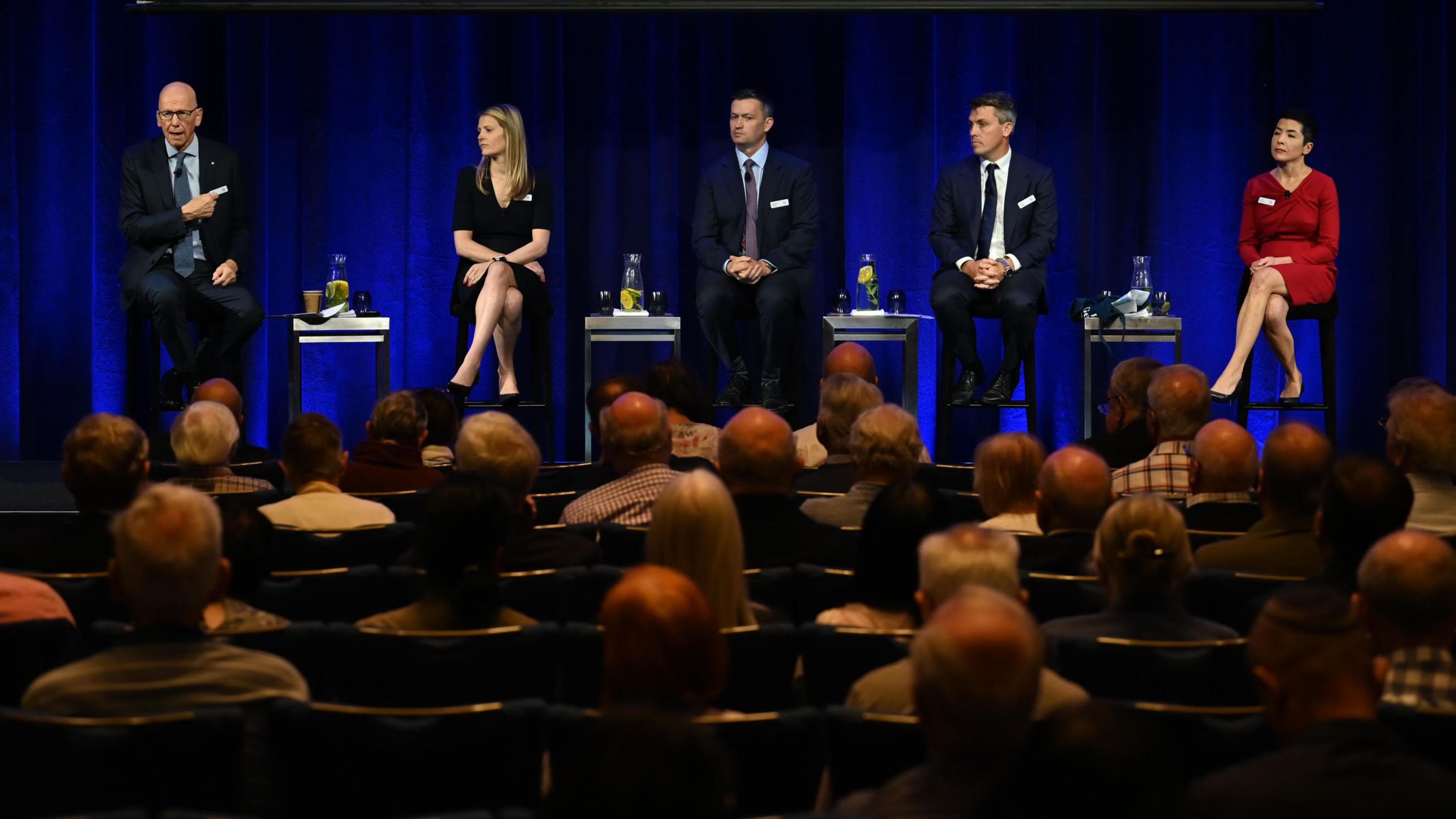
But first, Geoff Wilson's thoughts on the NTA discount
Unsurprisingly, Wilson believes the firm's discount to net tangible assets (NTA) on some of its LICs is an opportunity. To those not in the know, four of its eight LICs' share prices are currently trading at a discount to NTA.
"Someone asked me out in the foyer, 'What LIC should I buy at the moment?' To me, start off looking at the ones that are at a discount, because if you can buy a dollar of assets for 90 cents or 85 cents, you're better off doing that because you'll get the free kick if the share price can get to NTA," he said.
"That's why I said I think LICs are the thinking man's ETFs. If you've got no idea, buy an ETF."
While I may not agree with Geoff's sentiments on ETFs, I think it's important to make mention of the risks of investing in LICs that trade at a discount, given that these gaps to NTA can sometimes persist over longer periods than expected or worsen.
Just as falling stocks can be "value traps", LICs can be too, particularly if the company falls short of investor expectations or if today's positive market momentum turns.
Even so, the shareholders I spoke with almost unanimously backed Wilson and the team to either close these discounts or see the gap as a bargain hunter's paradise.
For instance, Jeff (66) told me he owns almost every Wilson Asset Management LIC and argued that the discount was an "opportunity", noting that "Geoff understands retirees very well." Another investor, Dorothy, agrees, noting Wilson Asset Management "runs its businesses well."
Meanwhile, Bill (55) said the "discount to NTA doesn't worry me at all... I have a great deal of confidence in the businesses, so it's a great opportunity to increase my position." Likewise, Eddie (68) argued the "NTA discounts are really attractive", and said the risk of the discounts worsening is reduced thanks to the LICs' dividends.
However, Paul (78) said the discounts had been a "concern", but had similarly been investing more of his savings in WAM Capital (ASX: WAM) recently for its dividends.
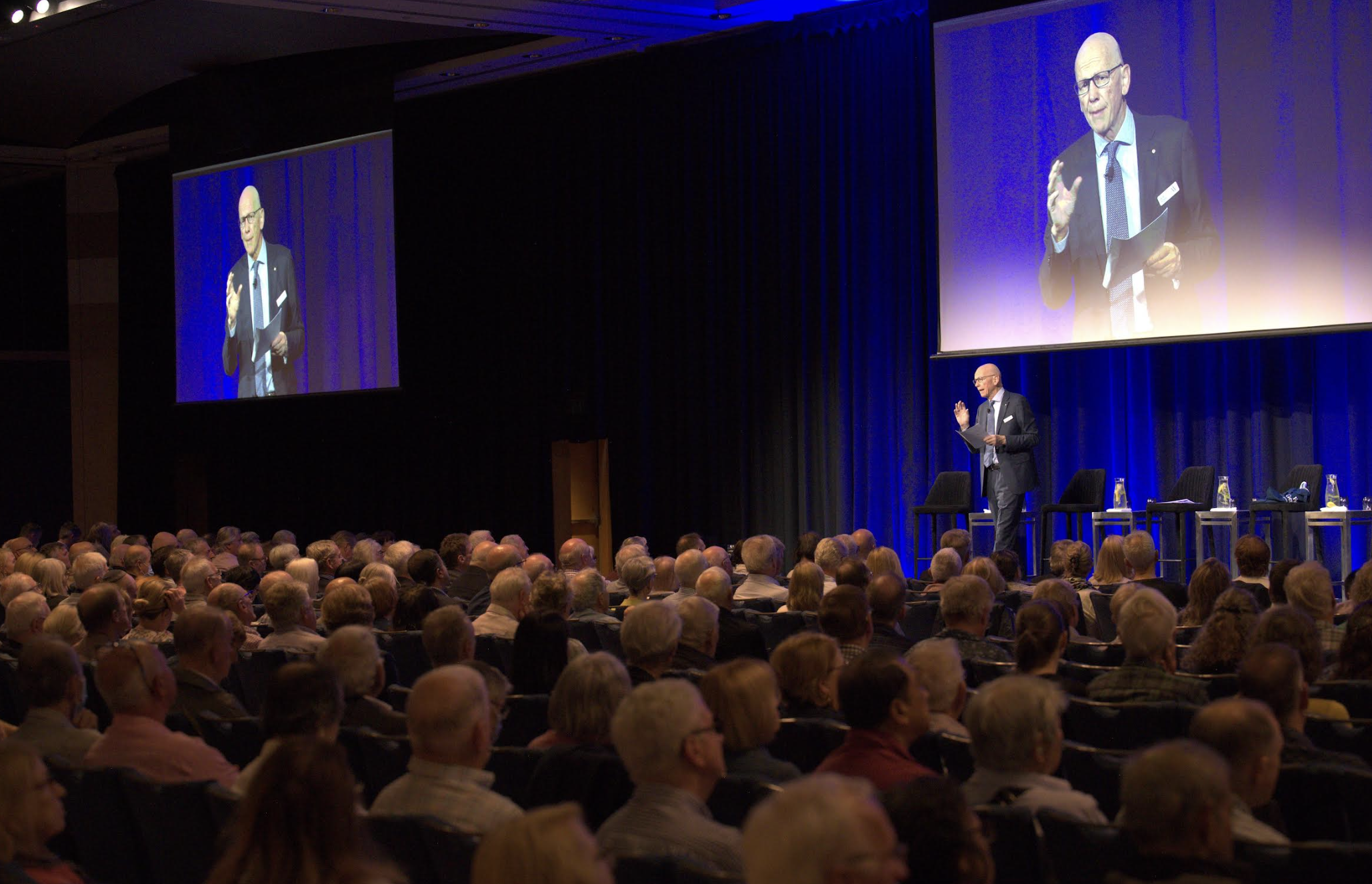
Where Catriona Burns sees opportunities on the global stage
Burns, who manages WAM Global (ASX: WGB), believes "artificial intelligence represents one of the biggest inflection points we've seen in over a decade."
In her presentation, she noted that one ChatGPT search uses 10 times the electricity of a Google search, so is searching for opportunities in critical assets and infrastructure to take advantage of this.
One of the portfolio's core holdings is Quanta Services (NYSE: PWR), the "biggest and best" utilities outsourcer in the US, tasked with upgrading and maintaining the grid.
"We look for multi-year earnings drivers and that critical assets and infrastructure thematic, we think, has significant longevity," she said.
Other structural themes the portfolio is exposed to include digital enterprises, electronic marketplaces, and innovative healthcare, in stocks like SAP (GY: SAP), Booz Allen Hamilton (NYSE: BAH), Intuit (NYSE: INTU), Intercontinental Exchange (NYSE: ICE), Tradeweb (NYSE: TW), CME Group (NYSE: CME), Icon (NASDAQ: ICLR), Avantor (NYSE: AVTR), Thermo Fisher Scientific (NYSE: TMO), Applus (BME: APPS), and Safran (EPA: SAF).
When identifying high-quality stocks for the portfolio, Burns noted that it's just as important which companies the team rules out as which are put in, arguing there are several industries and types of businesses WAM Global won't touch.
"What we're looking for is businesses that have advantaged industry positions [and] super high-quality management teams that we watch execute over time and, in many cases, who we've known for decades of time," she said.
Matthew Haupt's top large-cap opportunities
Meanwhile, Haupt, the lead portfolio manager of WAM Leaders (ASX: WLE), believes the mass confusion and lack of conviction in the broader market has seen investors flock to AI-exposed stocks.
While he doesn't believe we are in an AI bubble yet, he did note that bubbles are typically caused by three things: liquidity, scarcity or technological change.
"AI, really at the core, is a tool for companies to use for productivity or sales. Currently, the speculation is around the hardware and a lot of money is crowded into hardware," he explained.
"We are looking for this market to develop and broaden across into companies that will actually benefit from the technology and that's what we're really focused on."
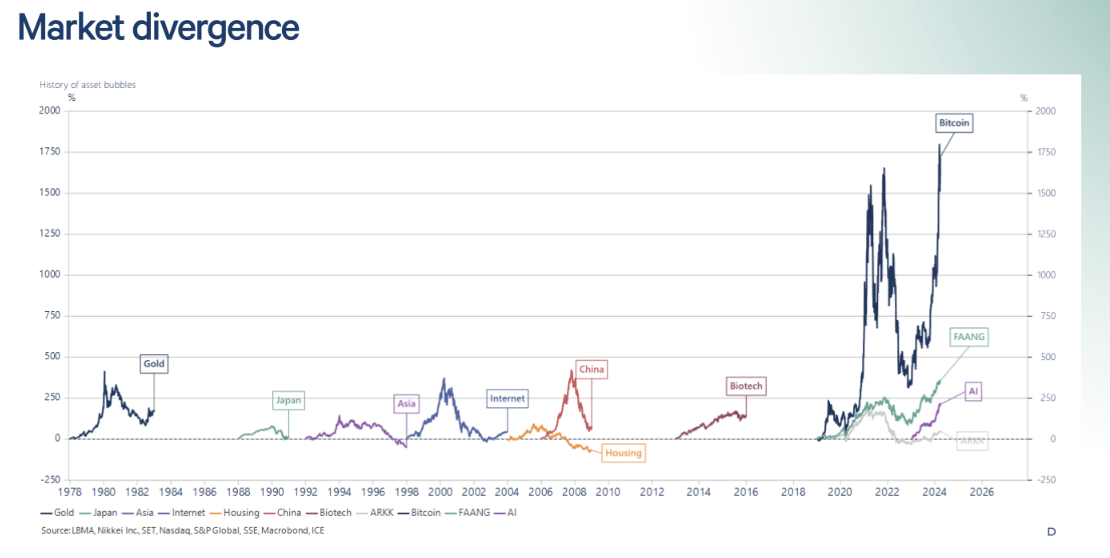
Haupt pointed to two surprising stocks as beneficiaries of AI on the cheap - including Telstra (ASX: TLS) and Santos (ASX: STO).
Telstra, he argued, is well-positioned to benefit from the growth in data connectivity.
"99% of data connectivity is run through subsea cables. Telstra owns over 400,000 kilometres of subsea cables - enough to lap the world 10 times over," he said.
Now, Telstra is rolling out fibre optic cables to connect Australia's capital cities - so, Haupt believes that about 10% of the telco's business is exposed to potential growth.
Santos, on the other hand, is a cheap way to play the energy intensity of AI - as explored by Burns above.
"Over the next 10 years, electricity demand could double. And how is that going to be met? Is that going to be met through renewables? We don't think so. So, we think the gas journey has longer to play out and Santos is an incredibly cheap way of playing that thematic as well," Haupt said.
Unrelated to AI, Haupt also pointed to Treasury Wine Estates (ASX: TWE) as an out-of-love stock the team bought into when China imposed tariffs on Australian wines. Now, with these tariffs lifted, and a restructured business in place, Haupt and his team believe Treasury Wines will now be able to push volume and premium prices back into China.
WAM Leaders is underweight the Big Four banks, with Haupt arguing they are currently "ridiculously expensive". That said, he elects National Australia Bank (ASX: NAB) as his most preferred play and Westpac (ASX: WBC) as his least favourite.
Where Oscar Oberg is finding small-cap gems
Oberg is the lead portfolio manager of WAM Capital (ASX: WAM), WAM Microcap (ASX: WMI), WAM Research (ASX: WAX) and WAM Active (ASX: WAA).
As Livewire readers will undoubtedly know, small-cap companies have underperformed their large-cap counterparts in recent years. According to Oberg, this is mostly thanks to rising interest rates, inflation, geopolitical risks, and delayed impacts of COVID-19.
However, he noted that since the US Federal Reserve decided to pause hiking interest rates in December, we've seen a rally in small-cap companies (see below).
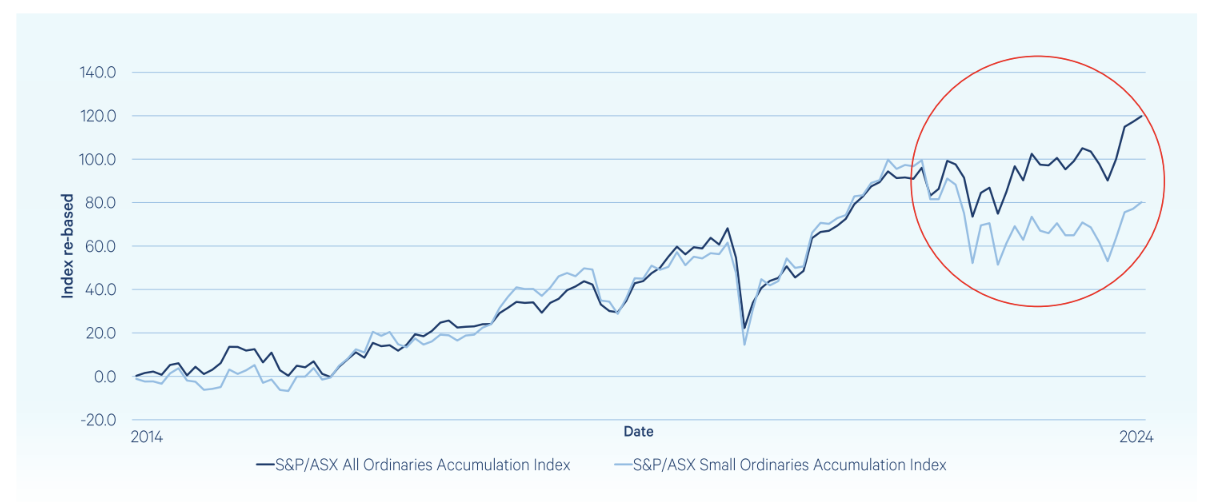
He pointed to Harvey Norman (ASX: HVN) as an example, which the team bought at around $3.50 last year. Since then, its share price has lifted around 39%.
"Supporting our view that small-cap companies can achieve is the sheer amount of takeovers that we've seen over this period - it's certainly the most amount of takeovers I've seen in my time at Wilson Asset Management," he said.
Over the last 12 months, there's been approximately $20 billion in small-cap industrial takeovers, 50% above the long-term average, he explained.
"We've been lucky in the portfolio to have had several takeovers, in companies such as Estia Health, Healthia, and SILK Laser Australia. We had one of our favourite companies, [MMA Offshore] (ASX: MRM), which we spoke about a couple of years ago, have a takeover last week," he said.
"We expect takeovers to continue. Small caps are cheap, valuations are cheap, the Australian dollar is low, and private equity funds are full of cash. So as we look forward, we're very positive on the outlook for small-cap and micro-cap companies."
In terms of AI beneficiaries, Oberg believes there are two broad categories of companies that will benefit: those that will achieve higher levels of revenue growth and those that will see a lower cost base.
He believes that NEXTDC (ASX: NXT) and Pro Medicus (ASX: PME) are two stocks that will see accelerated revenue growth from AI, while e-commerce retailers Temple and Webster (ASX: TPW) and Kogan (ASX: KGN) will be able to lower their costs because of it.
"Our catalyst to buy shares in Megaport came from the announcement of the new chief executive officer Michael Reid, which happened in April last year," he said.
Slightly horrifyingly, an AI version of Oberg then proceeded to explain his thesis on the screen, noting:
"Our continued research on Megaport over the last year suggests that the company will benefit from AI due to increased customer growth and larger contract wins. We think the business can beat revenue and earnings expectations, which could lead to a rerating of the share price over the next few years. Thanks for your time today and please don't think I can replace Oscar and the other members of the WAM Capital team... yet."
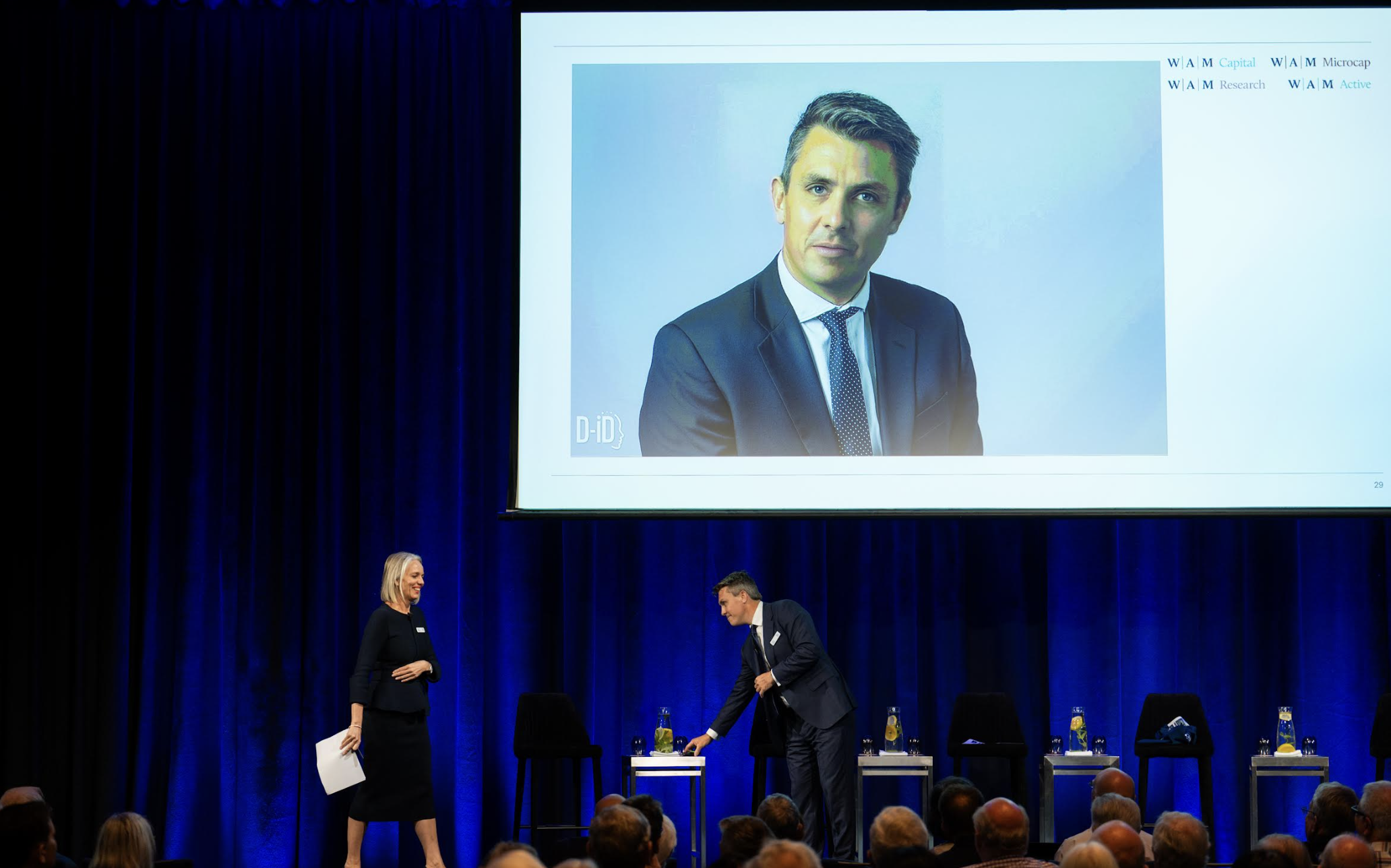
Dania Zinurova on humanity's most precious asset (and how you can invest in it)
Zinurova, who manages WAM's Alternative Assets LIC (ASX: WMA), was the only portfolio manager who did not talk to AI on Thursday, turning to life's most precious asset instead: our health.
"We all want to be well. We all want to live as long as possible. So as a portfolio manager, I see healthcare assets and healthcare businesses as the most valuable investments in the portfolio. We have over 10% invested in the sector and it's a growing allocation," she said.
Zinurova believes the fundamentals in healthcare are impossible to ignore, noting that future hospital admissions are expected to grow, and there are not enough hospital beds or nurses to meet this demand.
"We currently spend $96 billion on Australian hospital care each year, and the ageing population in Australia is expected to double by 2060," she added.
In addition, the forecasted demand for GP services significantly outstrips the number of GPs in Australia.
"This is happening regardless of where we are in the economic cycle because health is our most precious asset," she said.

Unlike the other LICs mentioned in this piece, WMA invests in unlisted, privately owned assets, via private equity, real estate, private debt, and infrastructure investments.
"Their values do not change day to day. They have great potential to deliver fairly stable income returns over time but also strong capital growth. All this with lower volatility," she says.
She believes the return potential of private assets is far greater than Australia's great love affair - property, noting that while property doubles in value every 10 years, private assets can potentially triple investors' savings every five to seven years.
5 topics
29 stocks mentioned
3 contributors mentioned

